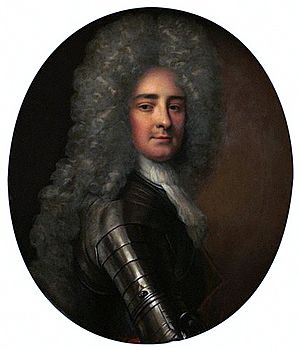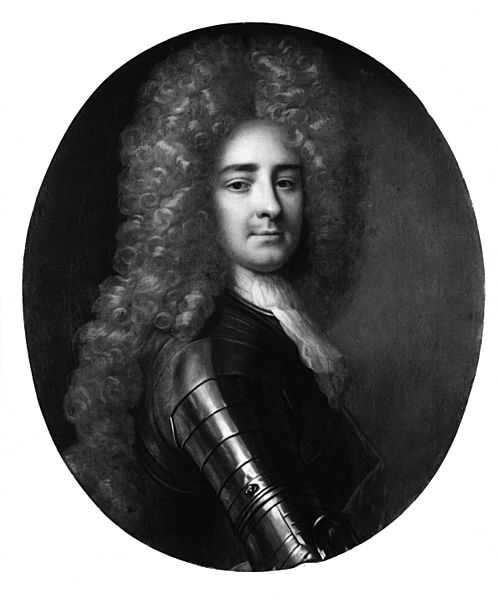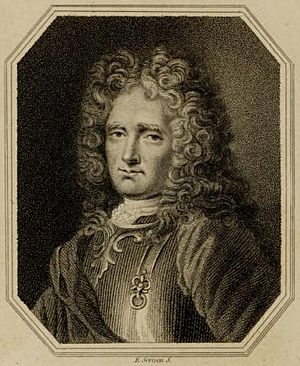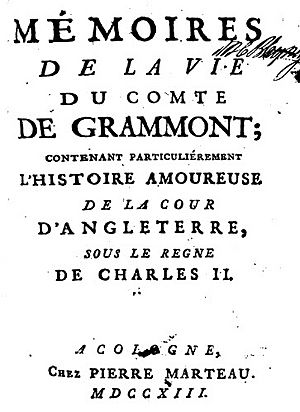Antoine Hamilton facts for kids
Quick facts for kids
Anthony Hamilton
|
|
|---|---|
|
Detail from the portrait below
|
|
| Born | 1644 or 1645 Ireland, probably Nenagh |
| Died | 21 April 1719 Saint-Germain-en-Laye, France |
| Father | George Hamilton, 1st Baronet |
| Mother | Mary Butler |
Anthony Hamilton (around 1645 – 1719) was a soldier and a famous writer. He was also known as Antoine or Count Hamilton.
Anthony came from a Catholic family in Ireland and Scotland. When he was a child in 1651, his parents took him to France. This was because Oliver Cromwell's army had taken over Ireland.
Later, Anthony became a soldier. He fought for France in the Franco-Dutch War (1672–1678). In 1685, a Catholic king, James II, became king of England. Anthony then joined the Irish Army and fought for King James in the Williamite War (1689–1691). He took part in battles like Newtownbutler and the Boyne. After King James's defeat, Anthony went back to France for good. He lived in Saint-Germain-en-Laye.
Anthony started writing only after his army career ended. He lived at the court of King James II, who was in exile in France. Anthony chose to write in French, using a fun and elegant style. He wanted to make his readers laugh and enjoy his stories. He is most famous for his book, Mémoires du Comte de Grammont. This book is about the time his brother-in-law, Philibert de Gramont, spent at the court of King Charles II. These memoirs are a classic in French literature. They also tell us a lot about the history of England during the English Restoration period.
| clear:right | ||||||||||||||||||||||||||||||||||||||||||||||||||||||||||||||||||||||||||||||||||||||||||||||||||||||||||||||||||||||||||||||||||||||||||||||||||||||||||||||||||||||||||||||||||||||||||||||||||||||||||||||||||||||||||||||||||||||||||||||||||||||||||||||||||||||||||||||||||||||||||||||||||||||||||||||||||||||||||||||||||||||||||||||||||||||||||||||||||||||||||||||||||||||||||||||||||||||||||||||||||||||||||||||||||||
|---|---|---|---|---|---|---|---|---|---|---|---|---|---|---|---|---|---|---|---|---|---|---|---|---|---|---|---|---|---|---|---|---|---|---|---|---|---|---|---|---|---|---|---|---|---|---|---|---|---|---|---|---|---|---|---|---|---|---|---|---|---|---|---|---|---|---|---|---|---|---|---|---|---|---|---|---|---|---|---|---|---|---|---|---|---|---|---|---|---|---|---|---|---|---|---|---|---|---|---|---|---|---|---|---|---|---|---|---|---|---|---|---|---|---|---|---|---|---|---|---|---|---|---|---|---|---|---|---|---|---|---|---|---|---|---|---|---|---|---|---|---|---|---|---|---|---|---|---|---|---|---|---|---|---|---|---|---|---|---|---|---|---|---|---|---|---|---|---|---|---|---|---|---|---|---|---|---|---|---|---|---|---|---|---|---|---|---|---|---|---|---|---|---|---|---|---|---|---|---|---|---|---|---|---|---|---|---|---|---|---|---|---|---|---|---|---|---|---|---|---|---|---|---|---|---|---|---|---|---|---|---|---|---|---|---|---|---|---|---|---|---|---|---|---|---|---|---|---|---|---|---|---|---|---|---|---|---|---|---|---|---|---|---|---|---|---|---|---|---|---|---|---|---|---|---|---|---|---|---|---|---|---|---|---|---|---|---|---|---|---|---|---|---|---|---|---|---|---|---|---|---|---|---|---|---|---|---|---|---|---|---|---|---|---|---|---|---|---|---|---|---|---|---|---|---|---|---|---|---|---|---|---|---|---|---|---|---|---|---|---|---|---|---|---|---|---|---|---|---|---|---|---|---|---|---|---|---|---|---|---|---|---|---|---|---|---|---|---|---|---|---|---|---|---|---|---|---|---|---|---|---|---|---|---|---|---|---|---|---|---|---|---|---|---|---|---|---|---|---|---|---|---|---|---|---|---|---|---|---|---|---|---|---|---|---|---|---|---|---|---|
|
||||||||||||||||||||||||||||||||||||||||||||||||||||||||||||||||||||||||||||||||||||||||||||||||||||||||||||||||||||||||||||||||||||||||||||||||||||||||||||||||||||||||||||||||||||||||||||||||||||||||||||||||||||||||||||||||||||||||||||||||||||||||||||||||||||||||||||||||||||||||||||||||||||||||||||||||||||||||||||||||||||||||||||||||||||||||||||||||||||||||||||||||||||||||||||||||||||||||||||||||||||||||||||||||||||
Contents
Early Life and Family
Anthony Hamilton was born in Ireland, probably in Nenagh, County Tipperary. This was either in 1644 or 1645. He was the third son of George Hamilton and his wife Mary Butler.
His father was from Scotland. He supported the Marquess of Ormond, who was the king's representative in Ireland. This was during the Irish Confederate Wars and the Cromwellian conquest.
Anthony's mother, Mary Butler, was Irish. She was the sister of James Butler, who was also the Marquess of Ormond and Lord Lieutenant of Ireland. Her family, the Butlers, were an old English family who had lived in Ireland for a long time.
Anthony's father is sometimes confused with his great-uncle, who was also named George Hamilton and married a Mary Butler. Anthony was likely born in Nenagh, which his father was granted in 1640.
Anthony was one of nine children. His parents were both Catholic, and so was he.
Childhood During War
Anthony was born during the Irish Confederate War. His father, even though he was Catholic, supported the king's representative against the Irish rebels.
In May 1646, Anthony's mother took him and his siblings from Nenagh to Dublin for safety. Other family members were also moved to safety.
In 1647, Anthony's father returned to Dublin. He had secret orders to give Dublin to the English if needed, rather than to the Irish rebels. So, in July, Dublin was given to the English army. Anthony, his mother, and siblings stayed in Ireland until 1651.
In 1649, during the Cromwellian conquest, Anthony's father became the governor of Nenagh Castle. He tried to defend it when it was attacked in November 1650.
First Time in France
In December 1650, the Marquess of Ormond left for France. Anthony's father and his family followed in the spring of 1651. Anthony was about seven years old.
They went to Caen, a city in France. Anthony's aunt, Elizabeth Preston, helped them find a place to stay. Anthony's father and older brothers, James and George, served Charles II, who was then in exile. Anthony's mother later moved to Paris. The Hamilton brothers often visited the court of young King Charles II and his mother, Queen Henrietta Maria.
Return to England

In May 1660, King Charles II returned to England and took the throne. This event is known as the Restoration. Anthony's father and older brothers moved to the royal court in London. King Charles II gave back the family's land in Donalong, Ireland, to Anthony's father.
Anthony's older brothers, James and George, became courtiers at the palace. In 1661, King Charles helped James arrange a marriage. Early in 1661, Anthony's father also brought his wife and younger children to London. They all lived together in a house near the palace.
In January 1663, Anthony met Philibert, Chevalier de Gramont, a French nobleman who was in exile in London. Gramont had gotten into trouble with the French king.
Gramont easily fit in at the English court because French was spoken there. Anthony and Gramont became good friends. Gramont soon became part of the king's inner circle. Gramont married Anthony's sister, Elizabeth, in London in late 1663 or early 1664. In March 1664, the French king allowed Gramont to return to France.
Soldier in France
In 1667, Anthony's brother George refused to take an oath to the English king and went to France. It seems Anthony went with him. In 1671, George formed a new army regiment in Ireland for the French king. Anthony joined this regiment and fought in the Franco-Dutch War (1672–1678). His younger brother, Richard, also joined them later.
In 1672, Anthony's regiment was stationed in Liège and fought in the siege of Utrecht. In 1673, Captain Anthony was in Limerick, Ireland, recruiting more soldiers for the regiment.
Anthony likely fought with George in the Battle of Sinsheim in June 1674 and certainly at Entzheim in October. Both brothers were wounded at Entzheim. In the winter of 1674-1675, Anthony, George, and Richard traveled to England. George returned to France, while Anthony and Richard went to Ireland to recruit more soldiers. French ships picked up the new recruits in April 1675.
In July 1675, Anthony's regiment was at Sasbach, where George saw their commander, Turenne, die. In August, during the retreat from Sasbach, the regiment lost many soldiers. In June 1676, George was killed while leading the rearguard.
Anthony was supposedly given the title comte d'Hamilton after his brother's death, but it's not clear if this title was official. Another officer was chosen to lead the regiment instead of Anthony. Anthony left the army, and his brother Richard became a lieutenant-colonel. The Franco-Dutch War ended in August 1678.
Anthony seems to have lived in Ireland between 1677 and 1684. He might have been the "comte d'Hamilton" who performed in a ballet for the French king in 1681.
Return to Ireland and War
In February 1685, the Catholic James II became king of England. In April, King James sent Richard Talbot, a Catholic, to Ireland. Talbot's job was to replace Protestant officers in the Irish army with Catholic ones. Anthony and his younger brothers, Richard and John, were among those recruited.
Anthony was made a lieutenant-colonel in an infantry regiment. In August, he became the governor of Limerick, replacing a Protestant officer. Anthony openly attended Catholic Mass. In late 1686, he was appointed to the Irish privy council, a group of advisors to the king. In February 1687, Anthony was promoted to colonel.
In September 1688, King James asked for four Irish regiments to be sent to England. Anthony's regiment was one of them. The troops landed in England in October. Anthony's regiment was stationed in Portsmouth. The regiment surrendered in Portsmouth in December 1688. King James II left for France on December 23. It seems Anthony also fled to France and returned with the King to Ireland in March 1689.
In 1689, during the Williamite War, Anthony was promoted to major-general. He was given command of the dragoons (soldiers who rode horses but fought on foot) in an army sent to fight rebels in Enniskillen.
At the battle of Newtownbutler in July, Anthony commanded the cavalry. He was asked to chase enemy troops, but they led him into a trap, and his soldiers were defeated. Anthony was wounded in the leg and fled the battle. He was put on trial by a military court but was found innocent because of his family's influence. This event damaged his reputation as a soldier. When the first Irish Brigade was formed in 1690, the French insisted that neither Anthony nor Richard should be officers.
Anthony fought in the cavalry charges at the Battle of the Boyne in July 1690. He also fought at the Siege of Limerick by King William's forces. When William lifted the siege in August, Anthony was sent to France to report the news. He did not return to Ireland and was not at the Battle of Aughrim in 1691, where his youngest brother, John, was badly wounded and died.
Life in France and Death
Anthony Hamilton spent most of the last thirty years of his life, from about 1690 onwards, at the royal court in exile at Saint-Germain-en-Laye, France. He did not hold any official job, but King James II gave him a good pension, which was about £13 per month. He also had an apartment in the castle.
At Saint-Germain, Anthony became friends with the Bulkeley family, especially two daughters, Anne and Henrietta. Anne married Berwick, King James's son, in 1700. Anthony seemed to be in love with Henrietta. They did not marry because she had no dowry (money or property brought by a bride to her husband), and Anthony thought his pension was not enough to support a family.
Anthony was part of a group around the Duchess of Maine. He wrote his famous Mémoires partly at her home. In 1701, he went with Berwick on a trip to Rome to ask the new pope to support King James's followers.
In September 1701, King James II died at Saint-Germain. Anthony wrote a poem about his death. In 1703, the French king gave Anthony's sister Elizabeth a house near the Château de Versailles. Anthony often visited her there.
In 1704, Anthony visited his friend Gramont at his castle. There, he decided to write Gramont's memoirs. Gramont died in Paris in 1707. Anthony's sister Elizabeth also died in Paris in 1708.
In 1712, James III, also known as the Old Pretender (King James II's son), left Saint-Germain. This was because France was about to stop supporting King James's followers, which they did in 1713 with the Peace of Utrecht. Anthony's brother Richard followed James III, but Anthony stayed at Saint-Germain and was allowed to keep his apartment. The Queen Mother, Mary of Modena, also stayed there. Anthony met the young writer Voltaire around 1715.
Anthony Hamilton never married. He died at the Château Vieux of Saint-Germain-en-Laye on April 20, 1719, at the age of 74. He was buried the next day in the local church.
| Timeline | ||
|---|---|---|
| As his birth date is uncertain, so are all his ages. Italics for historical background. | ||
| Age | Date | Event |
| 0 | 1644 or 1645 | Born, probably at Nenagh in Ireland |
| 1 | May 1646 | Moved to Dublin with his mother. |
| 2 | 28 Jul 1647 | Ormond abandoned Dublin to the Parliamentarians. |
| 7 | Early in 1651 | Taken to France by his parents |
| 15 | 29 May 1660 | Restoration of King Charles II |
| 16 | 1660 | Followed Charles II to England |
| 18 | 15 Jan 1663 | Gramont arrived in London; |
| 19 | 1663/1664 | Sister Elizabeth married the chevalier de Gramont. |
| 27 | 1671 | Brother George raised an Irish regiment for French service. |
| 28 | Jun 1673 | Brother James fatally wounded in a sea-fight against the Dutch |
| 30 | 6 Oct 1674 | Wounded at the Battle of Entzheim |
| 31 | 1675 | Travelled to Ireland to recruit |
| 32 | 1676 | Brother George killed at the Col de Saverne |
| 34 | 1678 | Supposedly succeeded his brother George as "comte d'Hamilton" |
| 35 | 1679 | Father died. |
| 35 | Aug 1680 | Mother died. |
| 40 | 6 Feb 1685 | Accession of King James II, succeeding King Charles II |
| 41 | 1685 | Took service in the Irish army as Lieutenant-Colonel. |
| 40 | 1 Aug 1685 | Made governor of Limerick |
| 44 | 1688 | Sent to England to protect James II |
| 44 | 13 Feb 1689 | Accession of William and Mary, succeeding King James II |
| 44 | 12 Mar 1689 | King James II landed at Kinsale, Ireland |
| 44 | 31 Jul 1689 | Defeated at Newtownbutler |
| 45 | 1 Jul 1690 | Defeated at the Battle of the Boyne |
| 46 | Autumn 1690 | Went to France to report the raise of the Siege of Limerick |
| 56 | 16 Sep 1701 | James II died at Saint-Germain-en-Laye. |
| 60 | 1704 | Started writing the Mémoires du comte de Grammont. |
| 62 | 30 Jan 1707 | Friend Gramont died in Paris. |
| 63 | 3 Jun 1708 | Sister Elizabeth died in Paris. |
| 68 | 11 Apr 1713 | Peace of Utrecht ended the War of the Spanish Succession; |
| 69 | 1713 | Memoirs published anonymously |
| 74 | 20 Apr 1719 | Died at Saint-Germain-en-Laye, aged 74 |
Anthony Hamilton's Writings
Anthony Hamilton came from an English-speaking family, but he chose to write in French. People often wondered how a foreigner could write French so well, with such a light and elegant style.
Hamilton was a well-known author in the 1700s. Famous writers like Voltaire mentioned him with respect. Today, Hamilton is mainly known for one book: the Mémoires du Comte de Grammont. This was the only book published while he was alive. He also wrote at least five tales and many poems, songs, and letters. Here are some of his notable works:
- 1713 Mémoires de la vie du comte de Grammont [Memoirs of the Life of the Count of Grammont] (Cologne: Pierre Marteau), read online in French or in English
- 1730 Le Bélier [The Ram] (Paris: Jean François Josse), read online in French or in English
- 1730 Histoire de Fleur d'Epine [Thornflower Story] (Paris: Jean François Josse), read online in French or in English
- 1730 Quatre Facardins [Four Facardins] (Paris: Jean François Josse), read online in French or in English
- 1731 in Œuvres mêlées en prose et en vers [Miscellaneous works in prose and verse] (Paris: Jean François Josse):
- De l'usage de la vie dans la vieillesse [Of the use of life in old age], p. 63 of Poésies [Poems], read online
- Sur l'agonie du feu roi d'Angleterre [On the Agony of the King of England], p. 66 of Poésies [Poems], read online
- Epistle à monsieur le comte de Grammont [Epistle to Count Gramont], written in 1704, p. 1 of Epitres et lettres, read online in French or in English
- Zeneyde (or Zénéide), read online in French or in English
- 1776 L'Enchanteur Faustus [The Enchanter Faustus], read online in French or in English
Grammont Memoirs
The Mémoires du Comte de Gramont were meant to cover Gramont's whole life. However, they stop at his marriage. Hamilton pretended that Gramont told him the stories for the book. He started writing them in 1704 and finished in 1710.
For the first part of the memoirs, Gramont was Hamilton's only source. This part might be very similar to how Gramont told the stories. The second part, about England, seems to be more of Hamilton's own writing. The first edition's subtitle, "the lovelife of the English court," describes this part well. Hamilton had Gramont (who died in 1707) and Elizabeth (who died in 1708) as witnesses for these stories.
The book was very popular and made Hamilton a classic French writer. It is still admired for its beautiful and elegant French. The memoirs were written to entertain, so they sometimes jump around in time. The book mixes memoirs, biography, and fiction.
The memoirs were first shared as handwritten copies. They were published in 1713, seemingly without Hamilton knowing. The publisher used a fake name, "Pierre Marteau," often used for books that censors might ban. In 1817, the Catholic Church put the book on its list of forbidden books, probably because of its content.
The first English translation came out in 1714. The translator hid people's full names, using only their initials, to avoid trouble.
Fairy Tales
Hamilton's tales, or short stories, were inspired by Charles Perrault's fairy tales (published in 1697) and Antoine Galland's Thousand and One Nights (published between 1704 and 1708). Hamilton's tales are like funny versions or fan fiction of these stories. They take place in fantasy worlds with fairy-tale or Middle Eastern settings. The characters' adventures are often strange, silly, or hard to understand, but they are meant to surprise and entertain.
Hamilton wrote Le Bélier in 1705. It tries to explain the name "Pontalie," which his sister Elizabeth made up for her house. Le Bélier is full of funny and absurd ideas. A famous line from it, "Belier, mon ami, tu me ferais plaisir si tu voulais commencer par le commencement" (Ram, my friend, you would please me if you would start at the beginning), became a proverb.
Following Thousand and One Nights, Hamilton wrote three ironic and wild tales: Fleur d'Épine, Zénéyde, and Les quatre Facardins. The last two were never finished. Fleur d'Épine was praised by the writer La Harpe. Zénéyde was written in 1695, as it mentions the death of the Archbishop of Paris, who died that year.
Hamilton's Enchanteur Faustus tells how the magician Faust makes Helen of Troy, Fair Rosamond, and other beautiful women appear before Queen Elizabeth of England. Unlike his other tales, this one is easy to follow. Hamilton dedicated it to his niece Margaret.
Hamilton's tales were shared privately as manuscripts during his lifetime. The first three were published in Paris in 1730, ten years after he died. A collection of his works published in 1731 included the unfinished Zénéyde. L'Enchanteur Faustus was published much later in 1776, but it might have been written even before the Memoirs.
Other Works
Hamilton also wrote songs and exchanged funny poems with the Duke of Berwick. He helped his niece, Claude Charlotte, write witty letters with Lady Mary Wortley Montagu.
See also
 In Spanish: Antoine Hamilton para niños
In Spanish: Antoine Hamilton para niños




